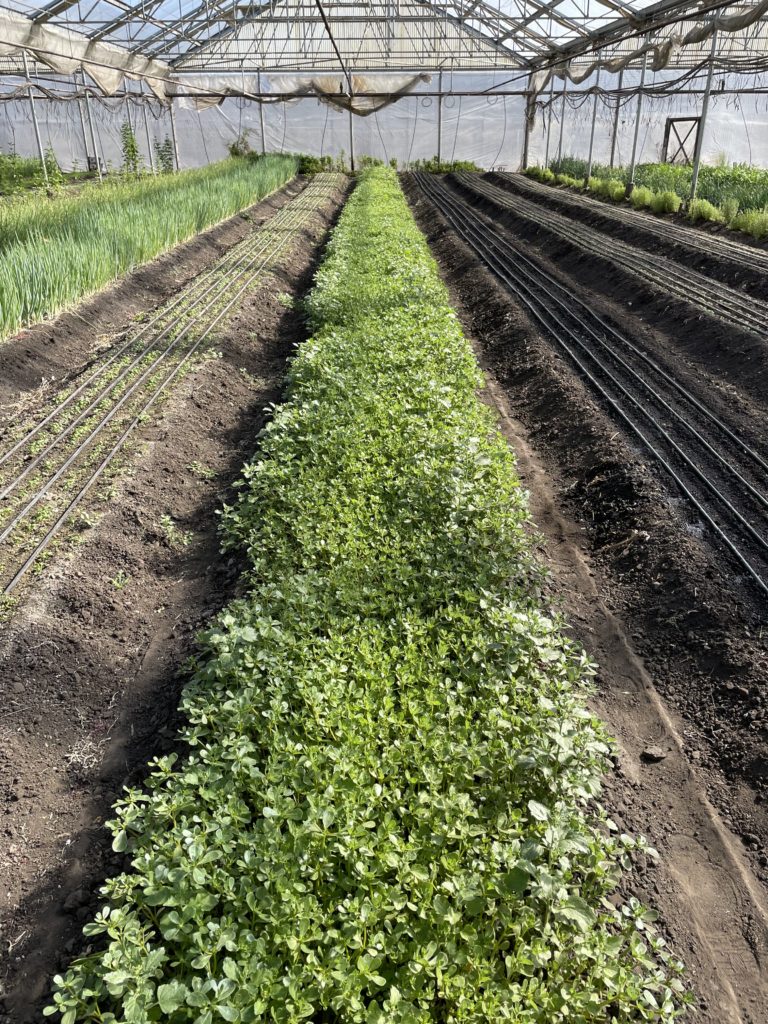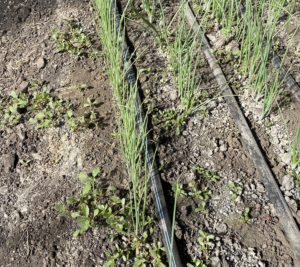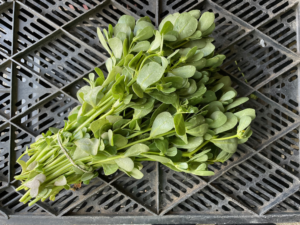I Beg Your Pardon

Purslane, cultivated as a crop
“April showers bring May flowers,” goes the old saying. If they were being accurate, the cliche makers of olde could have added: ”…and weeds too.” After a punishing period of drought we’ve finally had a few April showers, so we can expect plenty of weeds in May. I’ll be crabby about all the weeding we have to do this spring, but today, instead of complaining about the added labor costs, I’d like to change up the narrative and talk a bit about the positive role weeds can play in agriculture if we let them. But first, what is a weed?
Weeds are perhaps most charitably defined as “plants out of place.” This formula sounds good as a start but this clever quip reveals more about the person speaking than it does the plant in question. An objective observer has to ask, “‘Out of place’ according to WHO?” Take the archetypal “weed,” Cannabis sativa, for example. Talk about a “plant out place;” weed is a plant SO “out of place” that its very existence has been outlawed by the US government.
Not that the Cannabis plant itself cares about what governments think. From its humble roots as an aromatic herb growing in the wilds of central Asia, Cannabis sativa has not only continued to thrive in its natural habitat but has spread all over the world as a cultivated crop, finding its way into indoor closets and warehouses. It has even escaped cultivation to exist as a feral “weed” in ditches and fields in North America. People have taken advantage of this plant as a source of fiber, as a medicine, as an oil producer, as a food, and as a drug, and cannabis has taken advantage of people to care for it and propagate it.
Cannabis, like all “weeds,” is a plant that exists in relation to people. Our relationship with weeds is fraught; we resent the success that weeds enjoy in spite of our objections, so we have forgotten much of what weeds can teach us and we invent new ways to try and destroy them. In trying to rid ourselves of weeds we sometimes blindly contaminate our own water supplies with herbicides. But we might have fewer “weeds” if we learn to see how such successful plants can have a valued place in our world.
Many people would be surprised to learn that many of the “weeds” that populate our gardens were plants that we once cultivated in our gardens. Lactuca serriola, for example, which gardeners variously and inconsistently refer to as “wild lettuce,” “prickly lettuce,” or “Sow thistle” is the ancestor of the lettuce that’s for sale in the market. Not only is it edible, Sow thistle has more nutrients in it than “regular” lettuce. Lambsquarters, aka “dungweed” or “Goosefoot,” is an antique form of spinach. Stinging nettles, or Urtica dioica, is another “weed” that was imported here to the Americas from Europe as a food crop. French purslane, or Portulaca oleracea, is a common garden pest – until you learn to eat it! The Mexicans know this “weed” as verdolaga and esteem its use in the kitchen as a cooking green, like spinach. I’ve also enjoyed fresh purslane as a main ingredient in a flavorful, spritely Moroccan salad.
If more of us learned to use the weeds in our garden we’d have fewer “weeds” and a more diverse gardenscape. But weeds are perverse, temperamental and ornery. Besides being higher in vitamins and minerals than many of their more modern, refined, and esteemed cultivated cousins, many edible weeds are quite high in irony; I’ve been amazed to see that whenever I begin to make money by selling the weeds from my fields they tend to disappear from the rows.
The high nutrient value of weeds is not lost on the insects that feed on food crops. When I worked on Star Route Farm in the early 1980s my employer, Warren Weber, taught me to use some weeds as insect trap crops. Shepherd’s Purse, or Capsella bursa-pastoris, is a little weed in the Brassica family that would often germinate along with our rows of kale and broccoli. And frequently we would be plagued with wild mustards and wild radishes too, which are also brassicas, just as the kales and broccolis are. Warren said, “If we wait to weed out the kale and broccoli, the flea beetles will feed on them instead of our crops.” I observed that, time and time again, this was true. The insect pests preferred the weeds! So we would wait until the kales and broccolis were past their infancy and big enough to withstand the flea beetles before we cleaned out the “weeds” that the pests were feeding on, and our crops were happier for it.
When I was farming on my own and raising artichokes, I learned to leave a fringe of thorny, mean, milk thistle, or Silybum marianum, growing at the edge of the field, and they would tend to draw off most of the Artichoke plume moth, whose wormy larvae can bore into the tender artichoke buds. Then one day a visiting chef, Tiny Maes, who worked at Kokkari, a Greek restaurant, showed me how young Milk thistle plants can be used as a traditional, rustic, winter ravioli filling. Thistles, like so many other weeds, are forgotten foods
Besides being food crops and/or insectary crops, some weeds are valuable tools in monitoring soil health. Nettles will only germinate in soils that are very rich in nitrogen. Often you’ll find nettles thriving in abandoned corrals or fields where cattle or horses left lots of dung years before. When I see lots of nettles popping up I know that spinach, lettuce, and chard will all grow well, because they need lots of nitrogen to do well. But as the ambient nitrogen levels drop because the resource has been depleted then the nettles will disappear, and I’ll know it’s time to fertilize again.

Purslane in its wild “weed” form
Weeds can tell you when to plant too. Purslane, for example, only germinates when the soil is warm, so the first day I see a purslane sprout in the bed I know I can safely plant the seeds for a whole range of summer crops that would rot in cold soil. When the wild Tomatillo weeds sprout I know I can safely plant tomatoes. Other weeds can suggest crops to grow too. When there’s a lot of Poison Hemlock, or Conium maculatum, in a field you can bet that carrots will grow well there, as both plants are in the Umbellifer family. A healthy field of weeds promises a healthy field of crops (with enough work) just as a field where even the weeds struggle probably won’t bear happy vegetables without a lot of help.
Weeds are a problem, but they are not the worst problem a farm can have. Since they are almost inevitable companions if you don’t want to use herbicides, it can be good for a farmer’s mental health to remember their benefits. The days are getting longer, the soil is getting warmer, and because we had some nice rain, we’ll soon have a vigorous crop of weeds. Where it is convenient, I’ll wait as long as I can to turn the weeds under. Their roots reach down into the soil and bring up valuable minerals. Before they go to seed I’ll turn them under and treat them as a “cover crop.” Weeds will get the last laugh, I’m sure, but they can be useful jokers.

Tasty Mariquita purslane!
This week I’m putting Purslane or “vedolaga” in the harvest box. It’s hard to say this is a really a “weed” since I’ve grown it for several customers who have Mexican restaurants. Treat it like spinach and you’re off to a good start. It’s good in soups too. I used to grow it for Boulette’s Larder in San Francisco, and I bought the “Improved” French Purslane seed from a seed company but, irony of ironies, Chef Amyrll Shwertner prefered the wild, “weedy” form of the plant because it was smaller leaved and looked better on the plate. The Purslane seeds I’d bought became the weed!
© 2022 Essay by Andy Griffin
Photos by Andy Griffin


